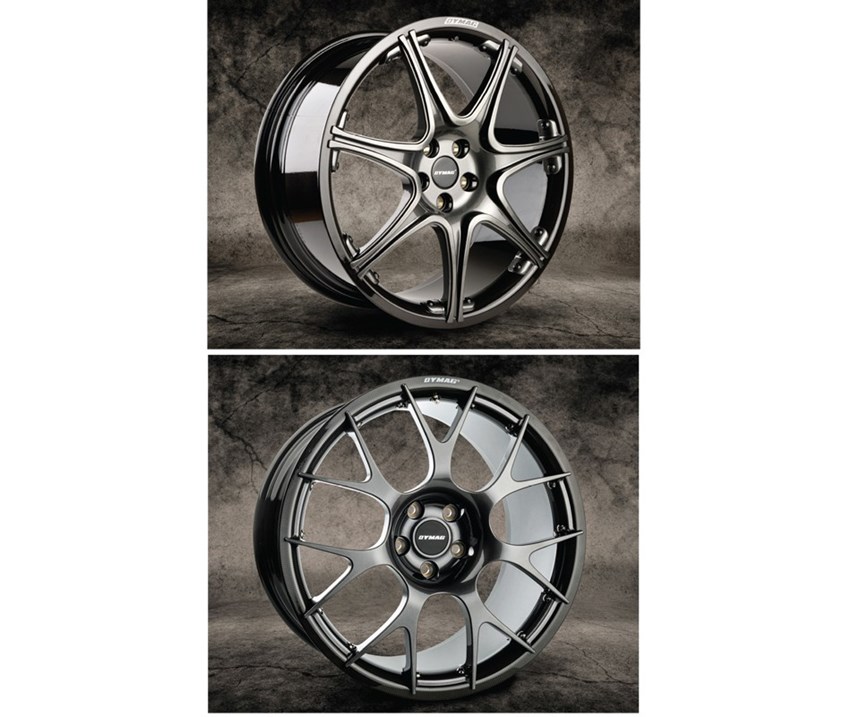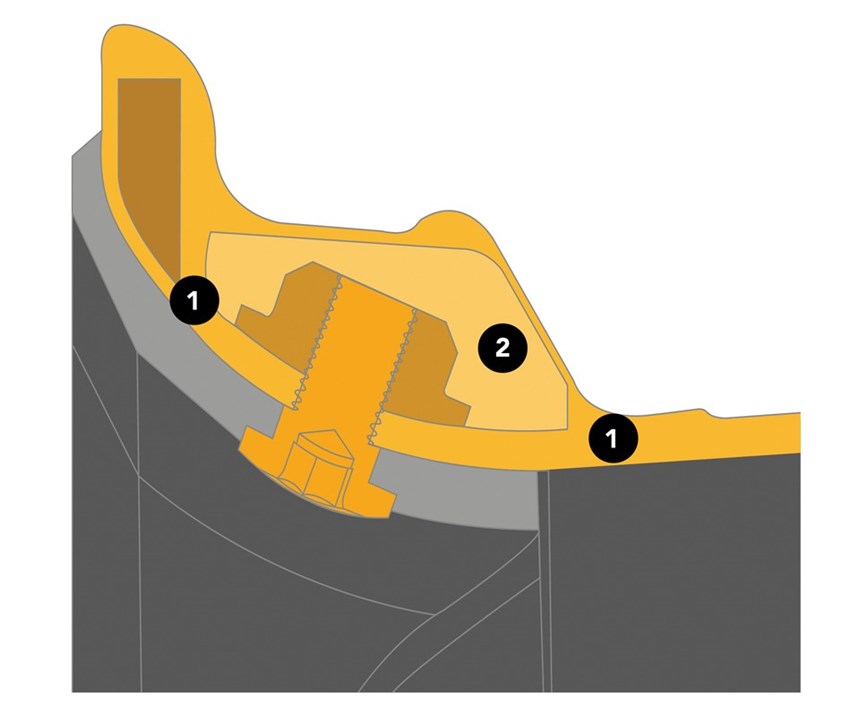Share
Composite materials have earned their way into cars and trucks, performing a variety of structural and semi-structural functions. Unit volumes, once limited to hundreds per model year, now increasingly number in the thousands. One application, however, has remained difficult to rein in from a composites perspective: the wheel.
It’s not that all-composite or hybrid composite wheels cannot be made. They can, and their benefits are substantial: up to 50% reduction in unsprung rotating mass vs. aluminum wheels, increased acceleration, more rapid braking, improved handling and reduced noise. But at the current minimum price of US$10,000 for a set of four, they are likely to be found only on the highest of high-end vehicles. Lamborghini. McLaren. And the like.
So, the ultimate goal — as it is with almost everything automotive-related — is to provide these benefits cost-effectively enough to find their way onto a broader range of vehicles. And if you are a manufacturer of composite wheels, cost-effectiveness comes neither easily nor overnight. It is achieved, instead, through innovation, creativity and hard work. And that only after you establish a place in the market with a quality product — quality measured not merely by mechanical performance but aesthetic appeal as well.
Great and great looking
British wheel manufacturer Dymag (Chippenham, Wiltshire, UK) knows well that how a wheel looks is as important as what it does. In 1995, the company developed what it says was the world’s first one-piece, carbon composite motorcycle wheel. This was followed in 2004 by a hybrid carbon fiber/aluminum wheel, sold primarily into the automotive aftermarket. In 2009, Dymag hit on hard times and was liquidated. Current CEO Chris Shelley acquired the Dymag name and was able to bring the senior engineering and production team back together, focused on returning to aftermarket composite and forged-aluminum motorcycle wheels. By 2015, Dymag had secured funding from the UK government to develop a new, patented product design and mass-production process for the next generation of durable, lightweight carbon composite automotive and motorcycle wheels.
Dymag now has on the market two carbon fiber/aluminum wheels, the BOXSTROM 7X and the recently launched BOXSTROM 7Y. Both feature a woven carbon fiber rim with bolted-in aluminum spokes. The wheels were both launched into the aftermarket, but Shelley says Dymag also has secured several OEM contracts, all for relatively high-end performance cars, including the Fisker EMotion all-electric sportscar.
Shelley notes the BOXSTROM wheels’ price point starts at £10,000 (~US$13,550) per set, “but that will come down as the technology matures and costs fall.” To reach the next level of volume (10,000-25,000+ wheels per year), he says, the price point needs to drop into the £5,000-£10,000 range (as low as ~US $6,775), with an even split between aftermarket and OEM sales.
Carbon fiber outside, aluminum inside
Most of the know-how in Dymag’s patented BOXSTROM is in the composite rim, which is made with preformed biaxial and triaxial carbon fiber fabrics (standard-modulus 12K and 50K tow) wrapped around a mandrel and then resin transfer molded (RTM). The epoxy resin system, Araldite XB 3292/Aradur 2954, is provided by Huntsman Advanced Materials (Switzerland) GmbH (Basel, Switzerland) and was initially chosen because it offered both high-temperature durability and high mechanicals, and met the processing requirements. This resin system, says Olivier de Verclos, Huntsman Advanced Materials’ technical support manager, also has been on the market for several years and, therefore, offers a level of reliability important to Dymag.
Much of the rim’s (or barrel’s) intellectual property rests in the BOXSTROM’s patented wheel flange and fastening system, which Shelley would not discuss in detail except to say that they incorporate a structural foam core and convey physical and mechanical performance not found in other composite or aluminum rims (see the graphic at top right). Overall, he argues, the design gives Dymag a technical edge on its competitors. “This is not just black aluminum,” he points out, “but a structure optimized for composites to reduce weight, while improving durability and safety.”
“Dymag wheels are designed and tested to the highest OEM specifications,” he adds, “as opposed to some other companies that aim to meet the minimum recommended aftermarket standards, but may fall well short — especially for high-performance tuned cars and tire packages that significantly exceed these aftermarket specifications in terms of load conditions.”
The question is often begged of carbon fiber/aluminum wheels, why use aluminum at all? Indeed, there are monobloc carbon wheels on the market that use carbon fiber in the rim and the spokes, thus there is no technological barrier to be cleared.
Shelley says it is simple: Carbon fiber limits design options in the spokes. Aluminum can be more easily adapted to a variety of spoke shapes, styles and designs, allowing aftermarket and OEM customers to meet a variety of end-user preferences and tastes. Indeed, spoke design has become a significant differentiator in the marketplace, so the material that best facilitates spoke design variation wins out. Where the wheels are tested to full OEM specifications, the weight differences between hybrid vs. monobloc is minimal compared to the large weight savings both offer vs. all-aluminum wheels. Shelley also notes that use of carbon fiber in spokes in high-performance applications may necessitate the design of larger cross-sections or additional carbon material to achieve the lateral spoke stiffness, because vehicle brake packages often limit the physical space available for a deep spoke design.
With Dymag’s BOXSTROM wheels, a typical 20-by-9.0-inch wheel designed and tested by an OEM checks in at about 9 kg, and Shelley says this will likely drop closer to 8 kg as spoke design is optimized. This compares to a traditional OEM cast-aluminum wheel, at 15 kg, or an OEM forged-aluminum wheel, at 12 kg. Such weight saving, Shelley notes, is very difficult for OEMs to ignore. “OEMs wouldn’t touch a carbon fiber wheel five years ago,” he argues. “But now they are all working on it for a combination of performance benefits and the drive for lower weight to reduce carbon emissions.”
Room for improvement
Increased OEM interest in carbon fiber wheels, although good for companies like Dymag, also brings with it more scrutiny and more pressure to improve materials and manufacturing processes, and reduce costs. Still, once developed, this wheel now capable of higher-volume manufacture also must meet safety and performance standards. Wheels are every vehicle’s touchpoints with the road, and as such, must perform flawlessly. “Wheels, tires and brakes are safety critical,” Shelley notes. “Taking weight out reduces margins of safety, which you don’t want to do without careful consideration.”
As part of this careful consideration, OEMs and companies like Dymag are developing standards for carbon fiber wheels, including radial cornering fatigue performance, impact performance, durability and more. Shelley believes that as OEMs develop a better understanding of composite materials, they will fine-tune and optimize these standards. “Our wheels still must perform as well as aluminum wheels in terms of durability, but taking the weight out of any wheel can reduce safety margins and compromise performance due to the lack of stiffness. This is a constant challenge for us,” Shelley says.
All of this has forced Dymag and other carbon fiber wheel manufacturers to seek opportunities to improve their products, and the processes that produce them. For example, although Huntsman’s epoxy is well-established, “Dymag is already looking at next-generation resins for future wheels,” Shelley reports. “We are committed to continue providing our partners with relevant data and we have already invested in, and have access to, state-of-art testing equipment. This enables us to simulate real-wheel service conditions to prove the reliability of the offered solutions and minimize the risks. With Huntsman Advanced Materials, we are working to achieve things like thermal stability, higher impact properties, less UV sensitivity, increased productivity and better aesthetics.”
Huntsman’s de Verclos acknowledges the push to reduce manufacturing costs, which is imperative if all-, partially or hybrid composite wheels are to become an option for high-volume vehicles. The company, he says, is working on material chemistry and manufacturing process optimization to achieve this. Shelley says, “Materials can be a little more expensive if you are reducing the amount of material being applied and creating production efficiencies.”
Aesthetically, OEMs are putting pressure on Dymag to improve surface quality. “The level of scrutiny that some of our customers put on the surface quality of our carbon fiber is going up,” Shelley says. “There can be absolutely no pinholes, no defects. This is really a major, major challenge.” Further, OEMs and their customers like to have the carbon fiber weave in wheel components exposed. Because of this, Dymag and its customers have developed an ABC hierarchy to characterize wheel material visibility: A=always visible; B=sometimes visible; C=never visible. A and B surfaces, as would be expected, receive the most attention to make sure they meet appearance requirements. “Aesthetics are paramount in the luxury and performance markets,” Shelley says.
To achieve this aesthetic, the choice of the resin system is crucial. Its selection has an impact on wheel color. “When it comes to color,” de Verclos explains, “using the right chemistry to increase productivity and performance is quite often playing against us. We have been able to design systems with good initial color, as well as color stability during service, without compromising on technical and process performance.”
Driving toward higher volumes
It is clear that composite materials, design tools and manufacturing processes are evolving in directions that will make carbon fiber wheels safer and more affordable. But when can the world expect to see them on high-volume vehicles? “The move towards lightweight vehicles is only set to intensify as OEMs look to a future without the combustion engine,” says Shelley. “For an electric vehicle, lightweight wheels will also extend range. However you look at it, the growing demand from OEM and aftermarket audiences for this kind of technology in the coming years can only help the transition to mass-market manufacturing and bring carbon composite wheels and their unparalleled benefits within the grasp of every driver.”
Related Content
The potential for thermoplastic composite nacelles
Collins Aerospace draws on global team, decades of experience to demonstrate large, curved AFP and welded structures for the next generation of aircraft.
Read MorePlant tour: Albany Engineered Composites, Rochester, N.H., U.S.
Efficient, high-quality, well-controlled composites manufacturing at volume is the mantra for this 3D weaving specialist.
Read MoreBio-based acrylonitrile for carbon fiber manufacture
The quest for a sustainable source of acrylonitrile for carbon fiber manufacture has made the leap from the lab to the market.
Read MoreCryo-compressed hydrogen, the best solution for storage and refueling stations?
Cryomotive’s CRYOGAS solution claims the highest storage density, lowest refueling cost and widest operating range without H2 losses while using one-fifth the carbon fiber required in compressed gas tanks.
Read MoreRead Next
Plant tour: Daher Shap’in TechCenter and composites production plant, Saint-Aignan-de-Grandlieu, France
Co-located R&D and production advance OOA thermosets, thermoplastics, welding, recycling and digital technologies for faster processing and certification of lighter, more sustainable composites.
Read MoreAll-recycled, needle-punched nonwoven CFRP slashes carbon footprint of Formula 2 seat
Dallara and Tenowo collaborate to produce a race-ready Formula 2 seat using recycled carbon fiber, reducing CO2 emissions by 97.5% compared to virgin materials.
Read MoreVIDEO: High-volume processing for fiberglass components
Cannon Ergos, a company specializing in high-ton presses and equipment for composites fabrication and plastics processing, displayed automotive and industrial components at CAMX 2024.
Read More


























